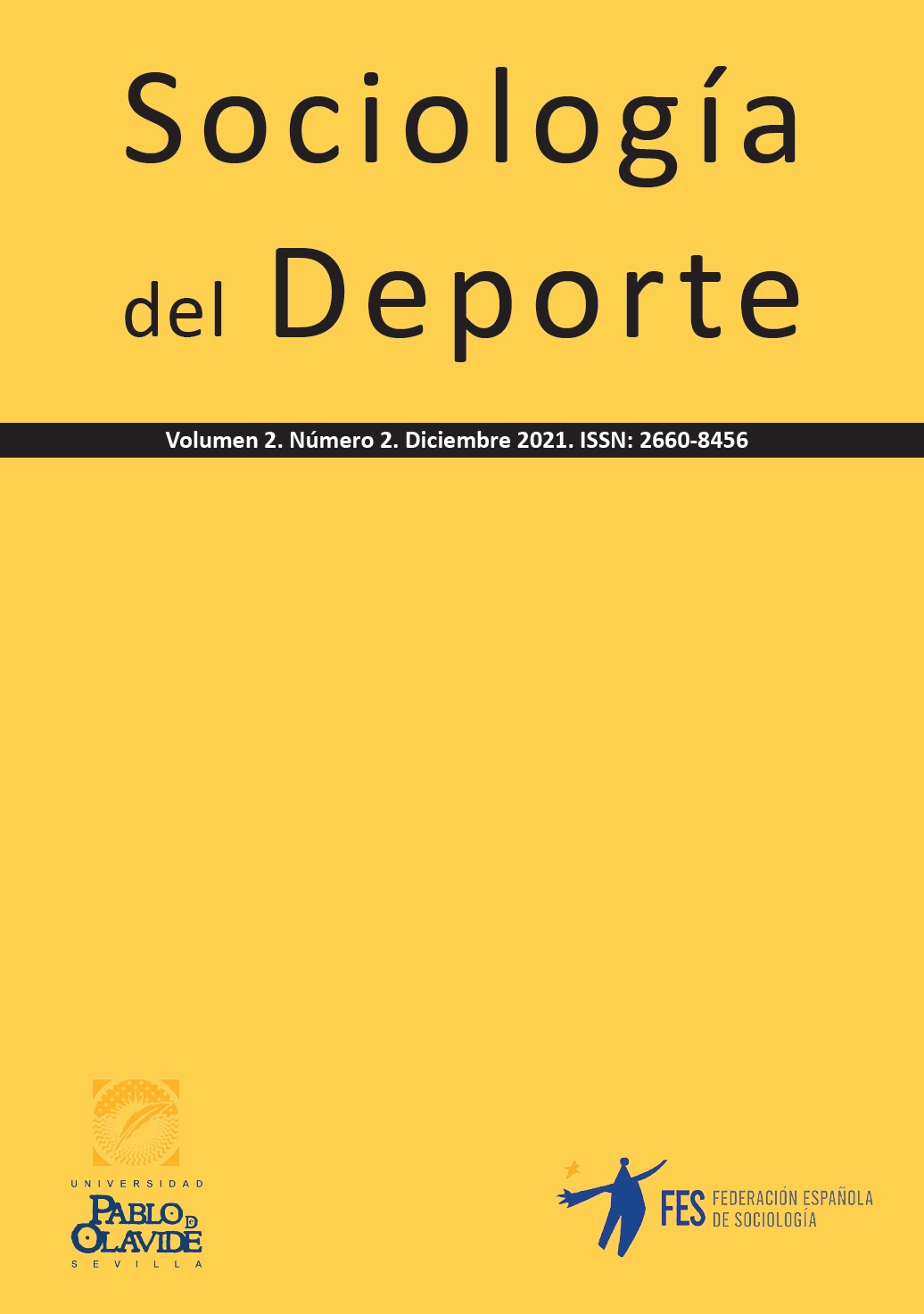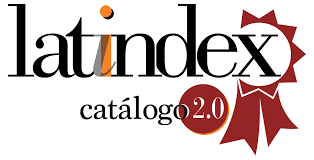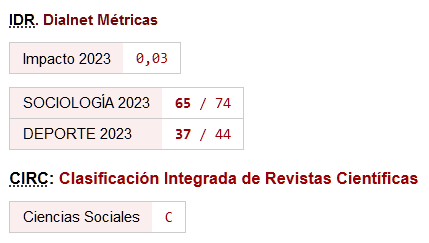The testosterone barrier in sport
DOI:
https://doi.org/10.46661/socioldeporte.6267Keywords:
Hyperandrogenism, Semenya, Sports Categories, DSD, Process-sociologyAbstract
World Athletics (formerly known as IAAF) has recently published the eligibility regulations for female classification that apply to running events from 400 meters up to the mile. The regulations have prevented some elite women athletes with DSD (Difference of Sexual Development) to compete or have made some of them to change their preferred running event in the 2020 Tokyo Olympics. According to World Athletics, female hyperandrogenism (a biological anomaly that naturally produces a high level of testosterone) must be in some way “compensated” to respect the fair play of the competition. Nonetheless, such argument rests upon a problematic assumption: hyperandrogenic women are not “natural” women —at least when it comes to compete in sports— so their “not-normal” condition must be fixed to meet the standards. Norbert Elias’s process-sociology helps to place the case of hyperandrogenic sportswomen within a broader context of power relations. In this fashion, we see that the case becomes problematic because these women athletes are perceived as a threat/disruption of one of the vertebral categories of sport: sex/gender. The testosterone barrier is to sex/gender what the colour barrier was to race in sports: a disciplinary strategy to maintain what is considered the “natural” sports categories of a certain era.
Downloads
References
Bermon, Stepháne, and Pierre-Yves Garnier. 2017. “Serum androgen levels and their relation to performance in track and feld: mass spectrometry results from 2127 observations in male and female elite athletes.” British Journal Sports Med 51(17):1309-1314. https://doi.org/10.1136/bjsports-2017-097792
Bermon, Stepháne, and Pierre-Yves Garnier. 2021. “Correction: Serum androgen levels and their relation to performance in track and field: mass spectrometry results from 2127 observations in male and female elite athletes.”
British Journal of Sports Medicine 55:e7. https://doi.org/10.1136/bjsports-2017-097792corr1
Brenner, Steve.2021. “Interview. Caster Semenya”. The Guardian. April 23. https://www.theguardian.com/sport/2021/apr/23/caster-semenya-theyre-killing-sport-people-want-extraordinary-performances
Chodosh, Sara. 2019. “The complicated truth about testosterone’s effect on athletic performance.” Popular Science. November 20. https://www.popsci.com/story/science/testosterone-effect-athletic-performance/
Court of Arbitration for Sport (CAS). 2015. “CAS 2014/A/3759 Dutee Chand v. Athletics Federation of India (AFI) & The International Association of Athletics Federations (IAAF).” Lausanne: Court of Arbitration for Sport.
Duarte, Fernando. 2020. “Caster Semenya: 'Once I thought she was cheat. Now I'm sure she belongs in women's athletics'.” BBC. September 11. https://www.bbc.com/sport/africa/54116114
Eitzen, Stanley. 1989. “The Sociology of Amateur Sport: an Overview.” International Review for the Sociology of Sport 24 (2): 95-104.
Elias, Norbert. 2007. Involvement and detachment. Dublin: UCD.
Enriquez, Juan and Steve Gullans. 2012. “Genetically enhanced Olympics are coming.” Nature 487(7407): 297-297.
Foucault, Michel. 1977. Discipline and Punish. New York: Pantheon Books.
Gleeson, Michael. 2021. “Jamaican sprinter defends DSD athletes after Mboma takes silver.” The Sydney Morning Herald. August 3. https://www.smh.com.au/sport/athletics/banned-from-400m-mboma-takes-silver-in-200m-thompson-herah-gold-20210803-p58fll.html
Hoberman, John M. 1997. Darwin's athletes: How sport has damaged Black America and preserved the myth of race. Boston:Houghton Mifflin Harcourt.
Human Rights Watch. 2020. “They’re Chasing Us Away from Sport” Human Rights Violations in Sex Testing of Elite Women Athletes. https://www.hrw.org/sites/default/files/media_2020/12/lgbt_athletes1120_web.pdf
Ingle, Sean. 2021a. “IOC admits guidelines for transgender athletes are not fit for purpose.” The Guardian. July 30. https://www.theguardian.com/sport/2021/jul/30/ioc-admits-guidelines-for-transgender-athletes-are-not-fit-for-purpose
Ingle, Sean. 2021b. “Coe claims Mboma’s Tokyo 200m silver shows testosterone rules are working”. The Guardian. August 4. https://www.theguardian.com/sport/2021/aug/04/sebastian-coe-claims-chrstine-mboma-tokyo-olympics-200m-silver-medal-shows-testosterone-rules-are-working
IOC .2021. “Framework on Fairness, Inclusion and Non-discrimination on the basis of gender identity and sex variations.” November 16. https://stillmed.olympics.com/media/Documents/News/2021/11/IOC-Framework-Fairness-Inclusion-Non-discrimination-2021.pdf?_ga=2.166782846.1301260854.1638003295-829218953.1638003295
Karkazis, Katrina. 2009. Fixing Sex: Intersex, Medical Authority, and Lived Experience. Durham: Duke Univ.Press.
Muñoz Fernández, Eugenio. 2021. "Me gustaría pedir una prueba a fondo para saber que es una mujer." Marca. August 3. https://www.marca.com/juegos-olimpicos/atletismo/2021/08/03/61089b8622601d50398b4657.html?fbclid=IwAR2uzChl6_ZVIHyGuatpgcTKsU76s7JTkjjCBUYtcMyVUoXCYhFOjOp7gtE
Pape, Madelaine .2019. “Expertise and non-binary bodies: Sex, gender and the case of Dutee Chand.” Body & Society 25(4): 3-28.
Pielke Jr., Roger. 2017. “Sugar, spice and everything nice: how to end ‘sex testing’ in international athletics.” International Journal of Sports Policy and Politics 9(4):649–665.
Pielke Jr., Roger, Ross Tucker, and Erik Boye. 2019. “Scientific integrity and the IAAF testosterone regulations.” The International Sports Law Journal 19(1): 18-26.
Reuters Staff. 2019. “Athletics: Radcliffe warns Semenya verdict could be death of women's sport.” Reuters. April 19. https://www.reuters.com/article/us-athletics-semenya-radcliffe-idUSKCN1RV0RM
Sánchez-García, Raúl. 2020. Las cuatro heridas del deporte moderno. Jaen: Piedra Papel.
Siegelbaum, Lewis H. and Sasu Siegelbaum. 2017. “Class and Sport.” In The Oxford Handbook of Sports History, edited by Robert Edelman y Wayne Wilson, 429-43.Oxford University Press.
Sönksen, Peter H., Richard I. Holt, Walailuk Böhning, Nishan Guha,David A. Cowan, Christiaan Bartlett, and Danmark. 2018. “Why do endocrine profiles in elite athletes differ between sports?” Clinical diabetes and endocrinology 4(1):1-16.
Swartz, Leslie and Brian Watermeyer. 2008. “Cyborg anxiety: Oscar Pistorius and the boundaries of what it means to be human.” Disability & Society, 23(2):187-190.
Teetzel, Sarah.2006. "On transgendered athletes, fairness and doping: An international challenge." Sport in Society 9(2): 227-251.
World Athletics. 2011. “IAAF to introduce eligibility rules for females with hyperandrogenism.” April 12. https://www.worldathletics.org/news/iaaf-news/iaaf-to-introduce-eligibility-rules-for-femal-1
World Athletics. 2018. “IAAF introduces new eligibility regulations for female classification.” World Athetics. April 26. https://www.worldathletics.org/news/press-release/eligibility-regulations-for-female-classifica
World Athletics. 2019. “Eligibility Regulations for the Female Classification
(Athletes with Differences in Sex Development).” 1 November. https://www.worldathletics.org/search/?q=the+eligibility+regulations+for+female+classification

Published
How to Cite
Issue
Section
License
Copyright (c) 2022 Raúl Sánchez García

This work is licensed under a Creative Commons Attribution-NonCommercial-ShareAlike 4.0 International License.








